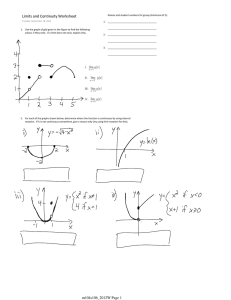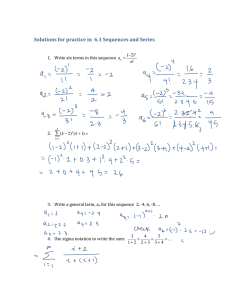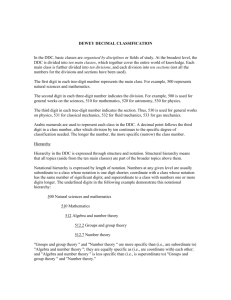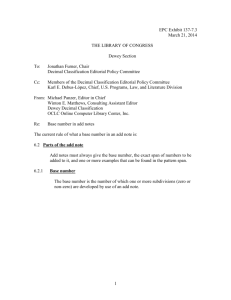GLOSSARY The Glossary defines terms used in the Introduction and throughout... and Manual. Fuller explanations and examples for many terms may...
advertisement
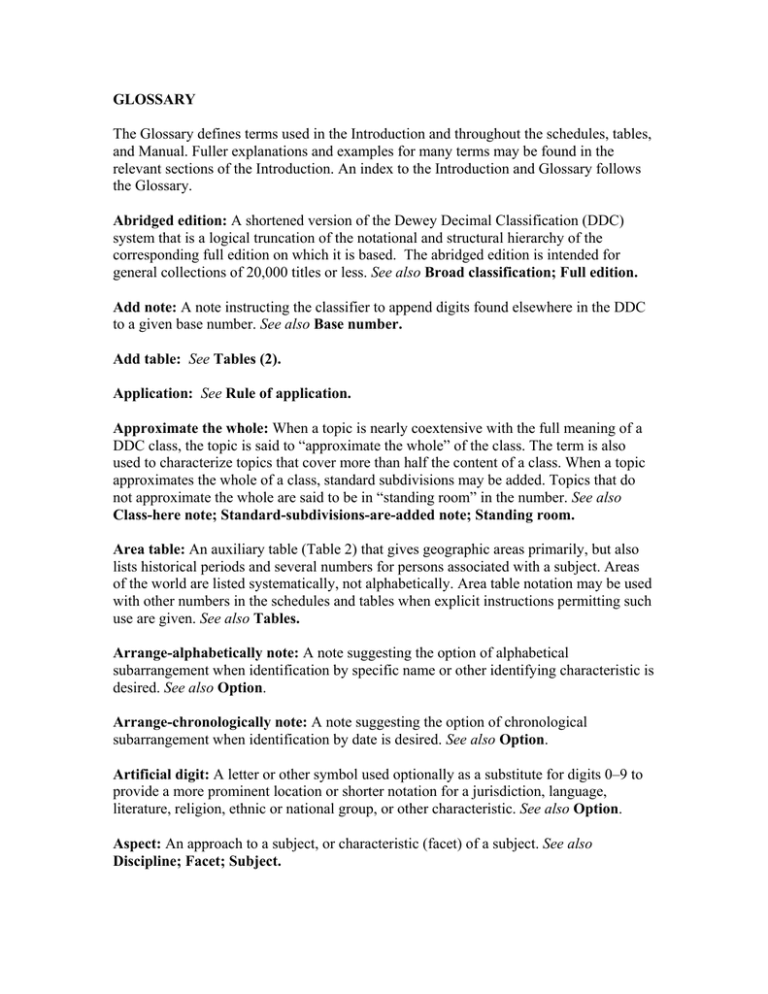
GLOSSARY The Glossary defines terms used in the Introduction and throughout the schedules, tables, and Manual. Fuller explanations and examples for many terms may be found in the relevant sections of the Introduction. An index to the Introduction and Glossary follows the Glossary. Abridged edition: A shortened version of the Dewey Decimal Classification (DDC) system that is a logical truncation of the notational and structural hierarchy of the corresponding full edition on which it is based. The abridged edition is intended for general collections of 20,000 titles or less. See also Broad classification; Full edition. Add note: A note instructing the classifier to append digits found elsewhere in the DDC to a given base number. See also Base number. Add table: See Tables (2). Application: See Rule of application. Approximate the whole: When a topic is nearly coextensive with the full meaning of a DDC class, the topic is said to “approximate the whole” of the class. The term is also used to characterize topics that cover more than half the content of a class. When a topic approximates the whole of a class, standard subdivisions may be added. Topics that do not approximate the whole are said to be in “standing room” in the number. See also Class-here note; Standard-subdivisions-are-added note; Standing room. Area table: An auxiliary table (Table 2) that gives geographic areas primarily, but also lists historical periods and several numbers for persons associated with a subject. Areas of the world are listed systematically, not alphabetically. Area table notation may be used with other numbers in the schedules and tables when explicit instructions permitting such use are given. See also Tables. Arrange-alphabetically note: A note suggesting the option of alphabetical subarrangement when identification by specific name or other identifying characteristic is desired. See also Option. Arrange-chronologically note: A note suggesting the option of chronological subarrangement when identification by date is desired. See also Option. Artificial digit: A letter or other symbol used optionally as a substitute for digits 0–9 to provide a more prominent location or shorter notation for a jurisdiction, language, literature, religion, ethnic or national group, or other characteristic. See also Option. Aspect: An approach to a subject, or characteristic (facet) of a subject. See also Discipline; Facet; Subject. Author number: See Book number. Base number: A number of any length to which other numbers are appended. See also Add note. Book number: The part of a call number that distinguishes a specific item from other items within the same class number. A library using the Cutter-Sanborn system can have D548d indicate David Copperfield by Dickens (where D stands for the D of Dickens, 548 stands for “ickens,” and d stands for David Copperfield). See also Call number; Cutter number; Work mark. Broad classification: The classification of works in broad categories by logical abridgment, even when more specific numbers are available, e.g., the use of 641.5 Cooking instead of 641.5972 Mexican cooking for a cookbook of Mexican recipes. Broad classification is the opposite of close classification. See also Abridged edition; Close classification. Built number: A number constructed according to add instructions stated or implied in the schedules or tables. See also Number building. Call number: A set of letters, numerals, or other symbols (in combination or alone) used by a library to identify a specific copy of a work. A call number may consist of the class number; book number; and other data such as date, volume number, copy number, and location symbol. See also Book number; Class number. Caption: See Heading. Category: See Class (Noun). Centered entry: An entry representing a subject covered by a span of numbers, e.g., 372–374 Specific levels of education. The entry is called “centered” because the span of numbers appears in the center of the page in the print version of the DDC rather than in the number column on the left side of the page. Centered entries are identified by the symbol > in the number column. Characteristic of division: See Facet. Citation order: The order in which two or more characteristics (facets) of a class are to be combined in number building. When number building is not permitted or possible, instructions on preference order with respect to the choice of facets are provided. See also Facet; Number building; Preference order. Class: (Noun) A category in the DDC formed on the basis of one or more characteristics and represented by a number. Classes explicitly provided in the tables and schedules are accompanied by a description consisting of a heading and often one or more notes. See 2 also Division; Entry (1); Main class; Section; Subdivision. (Verb) To assign a class number to an individual work. See also Classify. Class-elsewhere note: A note instructing the classifier about the location of interrelated topics. The note may show preference order, lead to the interdisciplinary or comprehensive number, override the first-of-two rule, or lead to broader or narrower numbers in the same hierarchical array that might otherwise be overlooked. See also Comprehensive number; Interdisciplinary number; Preference order. Class-here note: A note that identifies topics that are equivalent to the whole of the class under which the note appears. The topic as a whole is classed in the number under which the note appears; parts of the topic are classed in the most appropriate subdivision of the number. Topics identified in class-here notes, even if broader or narrower than the heading, are said to “approximate the whole” of the number; therefore, standard subdivisions may be added for topics in class-here notes. Class-here notes also may identify the comprehensive or interdisciplinary number for a subject. See also Approximate the whole; Comprehensive number; Interdisciplinary number. Class number: Notation used to represent a class in the DDC. See also Call number; Notation. Classification: A logical system for the arrangement of knowledge. Classified catalog: A catalog arranged according to the notational order of a classification system. Classify: (1) To arrange a collection of items according to a classification system. (2) To assign a class number to an individual work. Close classification: The classification of works to the fullest extent permitted by the notation. Close classification is the opposite of broad classification. See also Broad classification; Full edition. Coextensive: Describes a topic equal in scope to the concept represented by the number. Comparative table: A table provided for a complete or extensive revision that lists in alphabetical order selected topics accompanied by their number in the previous edition and their number in the current edition. See also Equivalence table; Revision. Complete revision: See Revision (Complete revision). Complex subject: A complex subject is a subject that has more than one characteristic. For example, “unemployed carpenters” is a complex subject because it has more than one characteristic (employment status and occupation). See also Preference order. 3 Comprehensive number: A number (often identified by a “Class here comprehensive works” note) that covers all the components of the subject treated within that discipline. The components may be in a span of consecutive numbers or distributed throughout the schedule or table. See also Interdisciplinary number. Concept: An idea represented in full or part by a class. Coordinate: Describes a number or topic at a level equal to another number or topic in the same hierarchy. Cross classification: The accidental placement of works on the same subject in two different class numbers. This tends to happen when works being classified deal with two or more characteristics of a subject in the same class. Notes on preference order should prevent cross classification. See also Preference order. Cross reference: See Class-elsewhere note; See-also reference; See reference. Cutter number: The notation in a book number derived from the Cutter Three-Figure Author Table, the Cutter-Sanborn Three-Figure Author Table, or the OCLC Four-Figure Cutter Tables. The OCLC Four-Figure Cutter Tables are revised and expanded versions of the Cutter Three-Figure Author Table and the Cutter-Sanborn Three-Figure Author Table. See also Book number. DDC: Dewey Decimal Classification. DDC Summaries: A listing of the first three levels (main classes, divisions, and sections) of the Dewey Decimal Classification system. The headings associated with the numbers in the summaries have been edited for browsing purposes, and may not match the complete headings found in the schedules. See also Division; Main class; Section; Summary. Decimal point: The dot that follows the third digit in a DDC number. In strict usage the word “decimal” is not accurate; however, common usage is followed in this edition’s explanatory material. Definition note: A note indicating the meaning of a term in the heading. Digit: The smallest individual unit in a notational system. For example, the notation 954 has three digits: 9, 5, and 4. Discipline: An organized field of study or branch of knowledge, e.g., 200 Religion, 530 Physics, 364 Criminology. In the DDC, subjects are arranged by disciplines. See also Subject. Discontinuation: The shifting of a topic or the entire contents of a number to a more general number in the same hierarchy, or the complete removal of the topic or number. A 4 topic or number is discontinued because the topic or concept represented by the number has a negligible current literature or represents a distinction that is no longer valid in the literature or common perception of the field. A note explaining its shift or removal accompanies a discontinued topic or number. Discontinued numbers appear in square brackets. See also Relocation; Schedule reduction. Displaced standard subdivision: A standard subdivision concept moved to a special provision in the schedule in place of its regular notation from Table 1. A do-not-use note is always provided at the regular location of the standard subdivision concept. See also Do-not-use note; Standard subdivisions. Division: The second level of subdivision in the DDC, represented by the first two digits in the notation, e.g., 64 in 640 Home and family management. See also DDC Summaries; Main class; Section. Do-not-use note: A note instructing the classifier not to use all or part of a regular standard subdivision notation, but instead to use a special provision or standard subdivision notation at a broader number. Also used to instruct the classifier not to use all or part of an add table provision, but instead to use a special provision. See also Displaced standard subdivision. Document: A generic term for all media capable of conveying, coding, and preserving knowledge. Documents may be books, journals, electronic resources, reports, sound recordings, motion pictures, etc. Dual provision: The inadvertent provision of more than one place in the DDC for the same aspect of a subject. Entry: (1) In the schedules and tables, a self-contained unit consisting of a number or span of numbers, a heading, and often one or more notes. (2) In the Relative Index, a term or phrase usually followed by a DDC number. (3) In the Manual, a self-contained unit consisting of a number or group of numbers, the associated headings or topics, and an extended instruction or discussion. Enumerative scheme: A classification system in which numbers for complex subjects are precombined and listed. Equivalence table: A table provided for a complete or extensive revision that lists in numerical order the classes of the current edition with their equivalent numbers in the previous edition (and vice versa). See also Revision. Expansion: The development of a class in the schedules or tables to provide further subdivisions. See also Revision. Extensive revision: See Revision (Extensive revision). 5 Facet: Any of the various categories into which a given class may be divided, e.g., division of the class “people” into the categories of ethnicity, age, education, and language spoken. Each category contains terms based on a single characteristic of division, e.g., children, adolescents, and adults are characteristics of division of the “ages” category. See also Citation order. Facet indicator: A digit used to introduce notation representing a characteristic of the subject. For example, “0” is often used as a facet indicator to introduce standard subdivision concepts. First-of-two rule: The rule instructing that works dealing equally with two subjects that are not used to introduce or explain one another are classed in the number coming first in the schedules or tables. Footnote: An instruction that applies to many subdivisions of a class, or to a topic within a class. The affected subdivision or topic is marked with a symbol such as an asterisk. In the print version of the DDC, the footnote is located at the bottom of the page. In the electronic version, the footnote is included in the notes section of each class to which the instruction applies. Former-heading note: A note listing the heading associated with the class number in the previous edition. The note is used when the heading has changed so much that it bears little or no resemblance to the previous heading, even though the meaning of the number has remained substantially the same. Full edition: The complete version of the Dewey Decimal Classification (DDC) system. See also Abridged edition; Close classification. Heading: The word or phrase used as the description of a given class. Also called “caption.” Hierarchical force: The principle that the attributes of a class as defined in the heading and in certain basic notes apply to all the subdivisions of the class, and to all other classes to which reference is made. Hierarchy: The arrangement of a classification system from general to specific. In the DDC, the length of the notation and the corresponding depth of indention of the heading usually indicate the degree of specificity of a class. See references and centered entries are used to indicate exceptions to the notational hierarchy. See also Centered entry; See reference. Hook number: A number in the DDC without meaning in itself, but used to introduce examples of the topic. Hook numbers have headings that begin with “Miscellaneous,” “Specific,” or “Other”; and do not contain add notes, including notes, or class-here notes. Standard subdivisions are always bracketed under hook numbers. 6 Including note: A note enumerating topics that are logically part of the class but are less extensive in scope than the concept represented by the class number. These topics do not have enough literature to warrant their own number. Standard subdivisions may not be added to the numbers for these topics. See also Literary warrant; Standing room. Indention: Typographical setting of notes and subheadings below and to the right of the main entry term. Influence: See Rule of application. Interdisciplinary number: A number (often identified by a “Class here interdisciplinary works” note) to be used for works covering a subject from the perspective of more than one discipline, including the discipline where the interdisciplinary number is located, e.g., the interdisciplinary number for marriage is 306.81 in Sociology. See also Comprehensive number. Literary form: A mode of literary expression such as poetry, drama, fiction, etc. Each form can be subdivided into kinds of forms, e.g., lyric poetry, comedy, science fiction, etc. Literary warrant: Justification for the development of a class or the explicit inclusion of a topic in the schedules, tables, or Relative Index, based on the existence of a body of literature on the topic. Main class: One of the ten major subdivisions of the DDC, represented by the first digit in the notation, e.g., 3 in 300 Social sciences. See also DDC Summaries; Division; Section. Manual: A guide to the use of the DDC that is made up primarily of extended discussions of problem areas in the application of the DDC. In the schedules and tables, see-Manual references indicate where relevant discussions are located in the Manual. See also Manual note. Manual note: An individual entry in the Manual. See also Entry (3); Manual; SeeManual reference. Notation: Numerals, letters, and/or symbols used to represent the main and subordinate divisions of a classification scheme. In the DDC, Arabic numerals are used to represent the classes, e.g., notation 07 from Table 1 and 511.3 from the schedules. See also Class number. Notational synthesis: See Number building. Note: An instruction, definition, or reference that explains the contents and use of a class, or the relationship of the class to other classes. See also Add note; Arrangealphabetically note; Arrange-chronologically note; Class-elsewhere note; Class-here 7 note; Definition note; Discontinuation; Do-not-use note; Footnote; Former-heading note; Including note; Manual note; Number-built note; Preference order; Relocation; Revision note; Scope note; See-also reference; See-Manual reference; See reference; Standard-subdivisions-are-added note; Subdivisions-are-added note; Variant-name note. Number building: The process of constructing a number by adding notation from the tables or other parts of the schedules to a base number. Also called “notational synthesis.” See also Base number; Citation order. Number-building note: See Add note. Number-built note: A note that states where the number building instructions may be found for a built number that is explicitly listed in the schedules or tables. Typically, such built numbers are listed for two reasons: to provide an entry for a built number under which other notes are required; or to provide an entry for a three-digit built number. Number column: In the print version of the DDC, the column of numbers that appears in the left margin of the schedules and tables, and to the right of the alphabetical entries in the Relative Index. Option: An alternative to standard notation provided in the schedules and tables to give emphasis to an aspect in a library’s collection not given preferred treatment in the standard notation. In some cases, an option may provide shorter notation for the aspect. See also Optional number. Optional number: (1) A number listed in parentheses in the schedules or tables that is an alternative to the standard notation. (2) A number constructed by following an option. See also Option. Order of preference: See Preference order. Period table: A table giving chronological time periods with their notation. For many literatures, period tables are given in the schedules. For works not limited to a particular language, the period notation is taken from Table 1 —0901–0905. See also Tables. Phoenix schedule: See Revision (Complete revision). Preference order: The order indicating which one of two or more numbers is to be chosen when different characteristics of a subject cannot be shown in full by number building. A note (sometimes containing a table of preference) indicates which characteristic is to be selected for works covering more than one characteristic. When a notation can be synthesized to show two or more characteristics, it is a matter of citation order. See also Citation order. Preference table: See Preference order. 8 Prime marks: See Segmentation. Reduction of schedules: See Schedule reduction. Regularization: The replacement of special developments for standard subdivision concepts by use of the regular standard subdivisions found in Table 1. Relative Index: The index to the DDC. It is called “Relative” because it shows the connection between subjects and the disciplines in which they appear. In the schedules, subjects are arranged within disciplines. In the Relative Index, subjects are listed alphabetically. Under each subject, the disciplines in which the subject is found are listed alphabetically. In the print version of the DDC, the disciplines are indented under the subject. In the electronic version, the disciplines appear as subheadings associated with the subject. Relocation: The shifting of a topic from one number to another number that differs from the old number in respects other than length. Notes at both ends of the relocation identify the new and former numbers. See also Discontinuation. Retroactive citation order: In number building, the combination of characteristics (facets) of a class starting with a number coming later in the schedule as the base number, then adding as instructed from numbers earlier in the sequence. Reused number: A number with a total change in meaning from one edition to another. Usually numbers are reused only in complete revisions or when the reused number has been vacant for two consecutive editions. Revision: The result of editorial work that alters the text of any class of the DDC. There are three degrees of revision: Routine revision is limited to updating terminology, clarifying notes, and providing modest expansions. Extensive revision involves a major reworking of subdivisions but leaves the main outline of the schedule intact. Complete revision (formerly called a phoenix) is a new development; the base number remains unchanged from the previous edition, but virtually all subdivisions are changed. Changes for complete and extensive revisions are shown through comparative and equivalence tables rather than through relocation notes in the schedule or table affected. See also Comparative table; Equivalence table. Revision note: A note that introduces a complete or extensive revision. Routine revision: See Revision (Routine revision). Rule of application: The rule instructing that works about the application of one subject to a second subject or the influence of one subject on another subject are classified with the second subject. 9 Rule of three: The rule instructing that works giving equal treatment to three or more subjects that are all subdivisions of a broader subject are classified in the first higher number that includes all of them. Rule of zero: The rule instructing that subdivisions beginning with zero should be avoided if there is a choice between the 0 subdivision and subdivisions beginning with 1–9 in the same position in the notation. Similarly, subdivisions beginning with 00 should be avoided when there is a choice between 00 and 0. Scatter note: A class-elsewhere, see-reference, or relocation note that leads to multiple locations in the DDC. See also Class-elsewhere note; Relocation; See reference. Schedule reduction: The elimination of certain provisions of a previous edition, often resulting in discontinued numbers. See also Discontinuation. Schedules: (1) Listings of subjects and their subdivisions arranged in a systematic order with notation given for each subject and its subdivisions. (2) The series of DDC numbers 000–999, their headings, and notes. Scope note: A note indicating that the meaning of a class number is broader or narrower than is apparent from the heading. Section: The third level of subdivision in the DDC, represented by the first three digits in the notation, e.g., 641 in 641 Food and drink. See also DDC Summaries; Division; Main class. See-also reference: (1) In the schedules and tables, a note leading to classes that are tangentially related to the topic and therefore might be confused with it. (2) In the Relative Index, a note leading to a synonym, broader term, or related term. (3) In the Manual, a note leading to related Manual notes. See-Manual reference: A note leading from an entry in the schedules or tables to additional information about the number in the Manual. See reference: A note (introduced by the word “for”) that leads from the stated or implied comprehensive or interdisciplinary number for a subject to component parts of the subject in numbers other than direct subdivisions of the original number or span. See also Class-elsewhere note. Segmentation: The indication of logical breaks in a number by a typographical device, e.g., slash marks or prime marks. Segmentation marks indicate the end of an abridged number. Shelf mark: See Call number. 10 Standard subdivisions: Subdivisions found in Table 1 that represent frequently recurring physical forms (dictionaries, periodicals) or approaches (history, research) applicable to any subject or discipline. They may be used with any number in the schedules and tables for topics that approximate the whole of the number unless there are instructions to the contrary. See also Tables. Standard-subdivisions-are-added note: A note indicating which topics in a multiterm heading may have standard subdivisions added to them. The designated topics are considered to approximate the whole of the number. See also Approximate the whole. Standing room: A term characterizing a topic without sufficient literature to have its own number, and considerably narrower in scope than the class number in which it is included. Standard subdivisions cannot be added to a topic in standing room, nor are other number-building techniques allowed. Topics listed in including notes have standing room in the class number, as do minor unnamed topics that logically fall in the same place in the DDC. To have standing room is the opposite of approximating the whole. See also Approximate the whole. Subdivision: (1) A subordinate member of a class, e.g., 518 Numerical analysis is a subdivision of class 510 Mathematics, and 518.5 Numerical approximation is a subdivision of 518. See also Class (Noun). (2) Notation that may be added to other numbers to make a class number appropriately specific to the work being classified. See also Standard Subdivisions; Tables. Subdivisions-are-added note: A note used where subdivisions are provided by add instructions indicating which topics in a multiterm heading may have subdivisions added to them. The designated topics are considered to approximate the whole of the number. See also Approximate the whole. Subject: An object of study. Also called topic. It may be a person or a group of persons, thing, place, process, activity, abstraction, or any combination of these. In the DDC, subjects are arranged by disciplines. A subject is often studied in more than one discipline, e.g., marriage is studied in several disciplines such as ethics, religion, sociology, and law. See also Discipline. Subject catalog: An index to the contents of a collection. If access is provided alphabetically by words, it is called an alphabetical subject catalog. If access is provided by the notation of a classification system, it is called a classified catalog. See also Classified catalog. Subordinate: Describes a number or topic at a lower (narrower) level than another number or topic in the same hierarchy. See also Superordinate. Summary: A listing of the chief subdivisions of a class that provides an overview of its structure. See also DDC Summaries. 11 Superordinate: Describes a number or topic at a higher (broader) level than another number or topic in the same hierarchy. See also Subordinate. Synthesis of notation: See Number building. Table of preference: See Preference order. Tables: In the DDC, lists of notation that may be added to other numbers to make a class number appropriately specific to the work being classified. The numbers found in a table are never used alone. There are two kinds of tables: (1) The six numbered auxiliary tables (Tables 1–6) representing standard subdivisions, geographic areas, languages, ethnic groups, etc. (2) Lists of special notation found in add notes under specific numbers throughout the schedules and occasionally in Tables 1–6. These lists are called add tables. See also Add note. Terminal zero: The one or two zeros appended to the notation for a division or main class to form a three-digit number. A single zero is added to the two-digit notation for a division to form a three-digit number, e.g., 51 + 0 = 510 Mathematics. Two zeros are added to the single-digit notation for a main class to form a three-digit number, e.g., 5 + 00 = 500 Science. See also Division; Main class. Topic: See Subject. Unabridged edition: See Full edition. Variant-name note: A note listing synonyms or near synonyms for a topic in a heading when it is awkward or inappropriate to include such information in the heading. Word-by-word alphabetization: Refers to the filing of entries word by word, not letter by letter. For example, New York files before Newark in word-by-word alphabetization; Newark files before New York in letter-by-letter alphabetization. Work: A distinct intellectual or artistic creation. Work mark: The part of a book number that consists of a letter appended to the author (or biographee) designation to show the first letter of the title (or first letter of the surname of the biographer). See also Book number. 12


